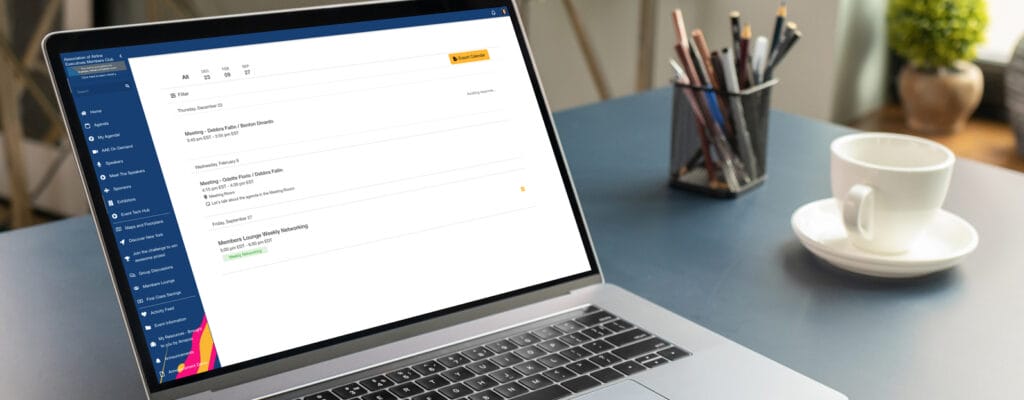Run of Show: How to Create, Distribute & Optimize Your Event Schedule
For anyone in the event management world, the term “run of show” is more than just jargon—it’s the backbone of smooth event execution. An expertly-crafted run of show ensures no detail is overlooked. It aligns everyone—event speakers, vendors, attendees—into a harmonious rhythm.
Looking for tips on how to put together your event schedule and make sure every moment of the big day unfolds seamlessly? Keep scrolling to learn how to create a top-notch run of show document.
What Is a Run of Show?
Whether you’re new to event planning or in need of a quick refresher, it’s important to understand what a run of show is and its role in the success of your event day! So, what does “run of show” mean? Your run of show is the script for your event. At its core, a run of show is a play-by-play of your event that maps out every detail, from keynote speakers to coffee breaks.

Knowing how to write a run of show is the first step to ensuring your event goes off without a hitch. It’s a chronological list of activities, presentations, and segments designed to keep your event on track. Following your run of show makes it easy to make sure your keynote speaker doesn’t overlap with the lunch break and your surprise guest isn’t kept waiting in the wings for too long.
What Is a Run of Show Document?
A run of show document contains a detailed breakdown of the sequence of events. Think of it as the guide that keeps everyone—from the caterers to the tech crew, speakers to entertainers—aligned and informed.
The run of show document includes time stamps, responsible personnel, locations, and key instructions, ensuring every event moment is executed seamlessly. It’s not just a list—it’s your event’s game plan that sets the stage (pun intended!) for a successful and organized occasion. Without it, your event team might not be on the same page and your event experience could go off the rails!
Recommended Resource: Does your team plan virtual events as well as in-person? Then you’ll want to add this virtual show flow template to your event toolkit! 🛠️
What Should a Run of Show Include?
Planning an event without a run of show is like trying to bake a cake without a recipe. You might end up with something that vaguely resembles what you had hoped for, but chances are it’ll be a hot mess! A comprehensive run of show gives you the exact ingredients and steps to make your event a success.
Here’s a quick peek at the essentials you should toss into your run of show mix:
- Event title: What’s your event called? This one’s a no-brainer.
- Event date: When’s the big day (or days)?
- Goals: What are you aiming to achieve?
- Programming agenda: A brief layout of the day’s events.
- Core event times: A show flow includes everything from registration and meal times to opening and closing ceremonies to set-up and tear-down schedules.
- Event flow: A sequential breakdown of activities.
- List of elements: What are the main components of your event?
- Speaker & session leader details: Who’s talking and about what?
- A/V and tech needs: Nobody likes technical difficulties!
- Script: A detailed narration or sequence for presentations or ceremonies.
- Logistics: The nitty-gritty—signage, seating arrangements, event layout, rentals, and the like.
- Sponsor recognition: A shoutout to those who’ve supported you.
- Back-up plans: It’s essential to have contingency plans when running a live event!
- Contact info: Make sure your team has a list of key contacts for anyone they might need to reach out to for support or questions on event day.
- Maps: Navigational aids for bigger venues.
- Notes: Any extra tidbits or reminders for the team.
With this handy list, you’re already off to a strong start. Read on for a more in-depth exploration of everything you should consider when you put together your run of show template for events.
How to Create a Run of Show
Crafting an impeccable run of show is like cooking a gourmet meal. You want the right ingredients, precise timing, and the flexibility to adapt on the go. Let’s break down how to create an event run of show step by step.

Set your event goal
Every event is designed to serve a specific purpose. For example, you might be planning to introduce a new product–or hosting an annual training event. Pinpointing your goal shapes the trajectory of your event and guides all of the decisions you’ll need to make–on everything from budgeting to marketing to programming.
Create a high-level timeline
Before diving into the details, create a broad timeline to visualize the event’s flow. Working from a conference run of show template, start by jotting down the significant milestones to ensure there’s a logical progression from start to finish.
Identify all components of your event
Every event, no matter its size, is a sum of multiple parts. From keynote sessions to breakout discussions and interactive workshops to networking breaks, make note of every single component to ensure nothing is left out.
Confirm your external factors
Speak with third-party speakers, workshop leaders, and sponsors. Verify details like rental deliveries and venue setup. This step is about aligning all external gears to ensure a cohesive event machine.
Set your schedule
What is the run of show schedule? It’s your chance to get granular. For each component of your event, allocate specific timings. This detailed breakdown will act as your minute-by-minute guide on the event day.
Confirm with internal & external stakeholders
No one likes surprises on event day. To check that your run of show meaning is clear across the board, check in with your team, run through the schedule together, and ensure everyone’s on the same page. Feedback here can be a lifesaver!
Finalize your event agenda
Once the bulk of your planning is done, consolidate everything into a streamlined agenda. Your attendees will likely refer to the agenda during the event, so it needs to be polished, easy to understand, and on-brand event.
Identify the “in between” tasks
It’s easy to overlook the micro-tasks. Whether it’s setting up a projector, arranging for a coffee refill, or prepping the stage for the next speaker, these mini-tasks ensure smooth transitions. Make sure you’ve allocated time and people to make these things happen.
Write your script
Does your event involve announcements or ceremonial addresses? Draft up the scripts ahead of time. It’s not just about the content, but ensuring info is delivered with the right pacing and at the right time. Make sure your event hosts are comfortable with the script beforehand!
Perform a stress test
A mock run allows you to anticipate potential hiccups. Run through a rehearsal of the event with a colleague or team member and refine the plan as you uncover challenges. Consider the event experience from the perspective of attendees, exhibitors, and speakers.
Create contingency plans
The best events have a robust backup strategy. To safeguard yourself from tech glitches, delayed deliveries, or unforeseen absences, always have a backup in place.
Share the run of show with your team
Now, distribute the finalized plan to your team. If you’re hosting your run of show template on Google Sheets, Excel, or Word, make sure your document share permissions are correct. With everyone informed and prepped on what to expect on event day, you’ve got a cohesive team unit ready to bring it all to life.
Run a pre-show kickoff
Just before the event begins, gather your troops for a pre-show kickoff meeting. A quick pep talk, alignment check, and some motivational words can make a world of difference.
Hold your event!
This is the culmination of all your careful planning. With a solid run of show in hand, you’re ready to host a memorable event.
Run an event post-mortem
Once the event wraps up, reconvene with your team. Reflect on how the event played out, celebrate the wins, and dissect the challenges so you can make adjustments and improvements for upcoming events. Plus, it’s always valuable to know if you met your event ROI goals!
Send out post-event surveys
Your audience’s feedback is invaluable when it comes to planning future events. Capture their insights, experiences, and suggestions.
Customize Attendee Experiences with Personalized Agendas
After all the effort that goes into creating an event run of show and planning your big day, you want to make sure your attendees can easily view the schedule, browse upcoming sessions, and attend their favorites. That’s where EventMobi’s interactive, personalized agendas come into play!
Why attendees appreciate interactive event agendas
EventMobi lets attendees tailor their event journey from their phones. With personalized event agendas, attendees can sort sessions by date, time, or track and then star sessions to add them to their personal schedule. In just a few taps, their event agenda is all mapped out!

Why you and your team will love in-app agendas
Which sessions are the crowd-pullers? Which ones need a venue shuffle? Your attendees get to plan and customize their own agenda, while you get the benefit of knowing which speakers are the biggest draws, which sessions are filling up fastest, and other insights. Post-event, you can deep dive into data to fine-tune future events. Plus, it’s digital—which means less paper and more love for the planet.
Pull Off Stellar Events with a Detailed Run of Show
There you have it–your guide to creating, distributing, and optimizing your event’s run of show. It’s not just about listing items on paper—it’s about designing a flow that transforms an ordinary event into an extraordinary experience.
The run of show is the map guiding every individual and element involved. While creating a run of show can seem intimidating, it’s worth it to pull off a smooth event with more happy attendees and less last-minute chaos for you!
Looking for event technology that works as hard as you do? Watch 8 short videos to see how EventMobi can elevate your events! 💪